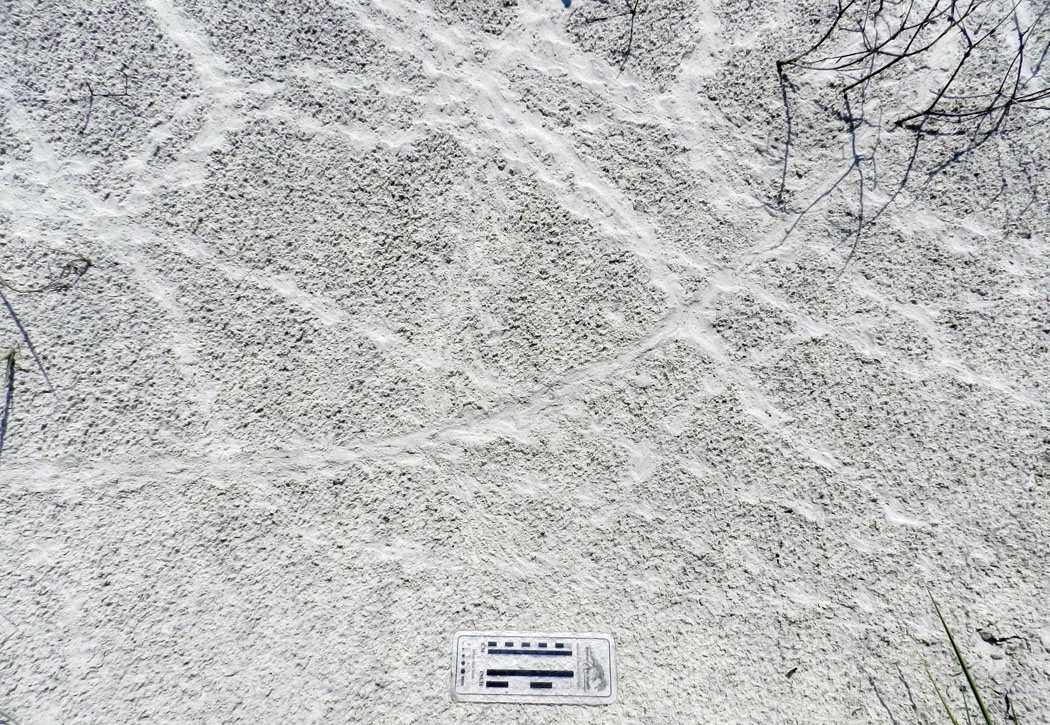For today’s photo of Georgia-coast traces and explanation of their meaning, we’ll look at some that are made only very briefly in the first moments of active life for their tracemakers, and in an environment very few of them will ever revisit. Moreover, those exceptional individuals who do make it back to the same environment – sometimes the same place where they took their baby steps – may take as long as three decades to do so. The traces are the trackways made by hatchling sea turtles, in this instance loggerhead turtles (Caretta caretta).
 Yeah, I know, there are a lot more than just six sea-turtle hatchling trackways here, but it’s at least six. Regardless, they’re still in the spirit of the holiday season. These tracks were made only moments after the hatchlings emerged from a buried hole nest, which was behind coastal dunes on St. Catherines Island, Georgia. They hatched early in the morning of July 31, 2011 and promptly began making tracks. (Photograph by Anthony Martin; scale in centimeters.)
Yeah, I know, there are a lot more than just six sea-turtle hatchling trackways here, but it’s at least six. Regardless, they’re still in the spirit of the holiday season. These tracks were made only moments after the hatchlings emerged from a buried hole nest, which was behind coastal dunes on St. Catherines Island, Georgia. They hatched early in the morning of July 31, 2011 and promptly began making tracks. (Photograph by Anthony Martin; scale in centimeters.)
The trackways are relatively simple, consisting of alternating front-back flipper impressions and central body drag marks that are vaguely defined in dry sand (like in the photo) but become gorgeously expressed in wet sand. Overall trackway patterns tend to loop and intersect one another close to the nest as they tried to get oriented toward the sea, then become more linear and cross one another less often once they find the beach and waddle down slope. Trackways may be tens of meters long, depending on how far hatchlings must travel from their nests to the surf zone.
As an ichnologist, what I find remarkable conceptually about hatchling traces is knowing that their makers only leave traces on land for a few minutes after they’re born. All successfully hatched sea-turtle eggs are located in nests above the high-tide mark, and on the Georgia coast these are normally behind the first line of coastal dunes along a sandy shoreline. Then, assuming the hatchlings don’t die during their brief and vulnerable time on land (raccoons and herons and ghost crabs – oh my!) and that they do make it into the sea, almost all of their remaining tracemaking behaviors will be done in the Atlantic Ocean.
In other words, you’ll have to be very patient and relatively young to see traces made by those same individual turtles on Georgia beaches and dunes again, and these will only be from adult females. About 15-30 years pass before sea turtles reach sexual maturity, meaning it will take at least that long for pregnant mother turtles to come ashore. Even then, they do this seasonally, from about May through August, so you will only see adult female and hatchling tracks in the middle of any given year. Thus loggerheads and other sea turtles collectively are important tracemakers on the Georgia coast, but individually are rare.
For paleontologists, the huge trackways, covering pits, hole nests, and other marks of sea turtles comprise a trace assemblage with a great potential for preservation in the fossil record. Sure enough, sea turtle trace fossils have been reported from Cretaceous Period rocks in the western U.S. More are likely out there, and I have little doubt that these will be found by applying the right search images. Who will recognize the first trace fossils of sea-turtle hatchlings? My bet is that it will be someone who saw a lot of modern ones, perhaps even some from the Georgia coast. Good luck!
Further Information
St. Catherines Island Sea Turtle Conservation Program. (Mostly done by Gale Bishop.)
Georgia Sea Turtle Center. Jekyll Island, Georgia.
Links to Previous Posts in This Theme
On the 12th Day of Ichnology, My Island Gave to Me: 12 Snails Grazing
On the 11th Day of Ichnology, My Island Gave to Me: 11 Plovers Probing
On the 10th Day of Ichnology, My Island Gave to Me: 10 Beetles Boring
On the 9th Day of Ichnology, My Island Gave to Me: 9 Molluscans Hiding
On the 8th Day of Ichnology, My Island Gave to Me: 8 Crab Legs Walking
On the 7th Day of Ichnology, My Island Gave to Me: 7 Lizards Looping
